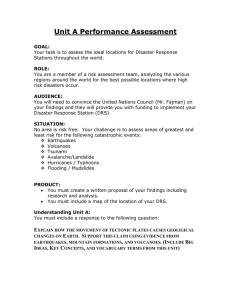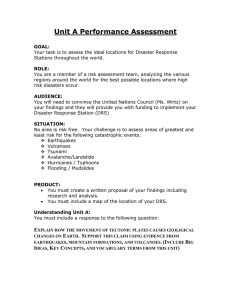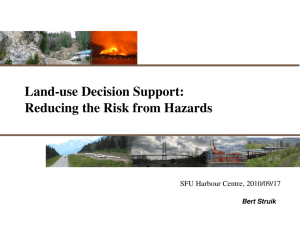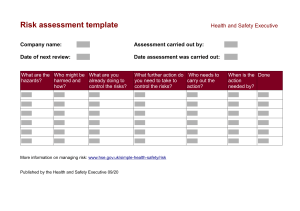Disaster Preparedness Guide: Typhoons, Earthquakes, Pandemics
advertisement
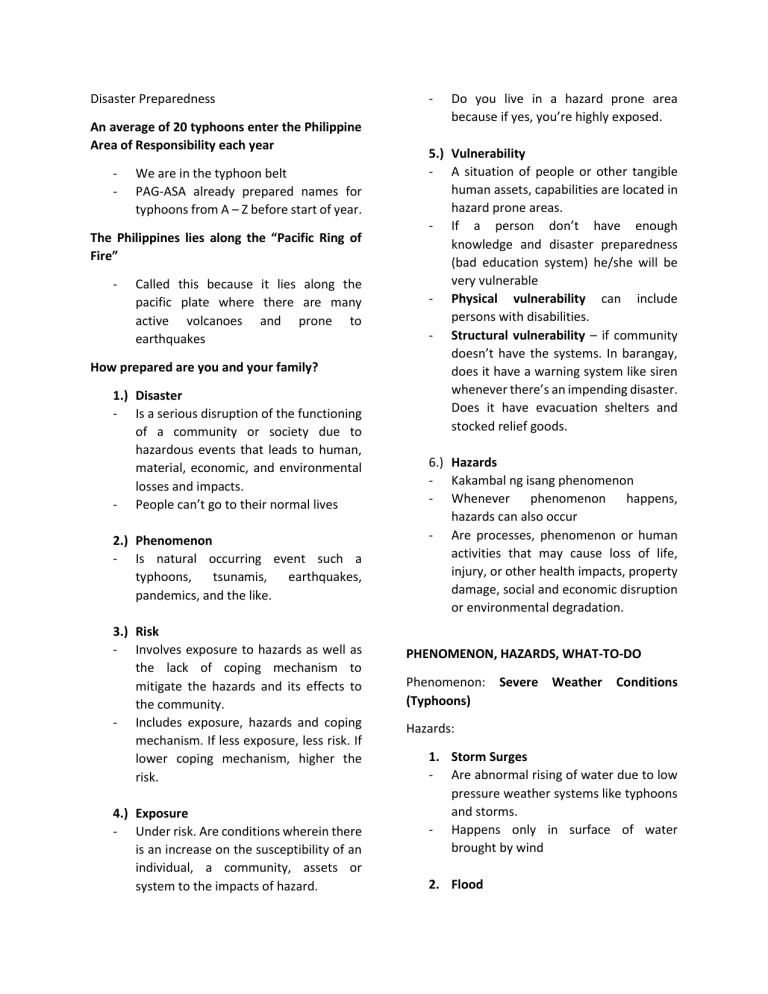
Disaster Preparedness An average of 20 typhoons enter the Philippine Area of Responsibility each year - We are in the typhoon belt PAG-ASA already prepared names for typhoons from A – Z before start of year. The Philippines lies along the “Pacific Ring of Fire” - Called this because it lies along the pacific plate where there are many active volcanoes and prone to earthquakes How prepared are you and your family? 1.) Disaster - Is a serious disruption of the functioning of a community or society due to hazardous events that leads to human, material, economic, and environmental losses and impacts. - People can’t go to their normal lives 2.) Phenomenon - Is natural occurring event such a typhoons, tsunamis, earthquakes, pandemics, and the like. 3.) Risk - Involves exposure to hazards as well as the lack of coping mechanism to mitigate the hazards and its effects to the community. - Includes exposure, hazards and coping mechanism. If less exposure, less risk. If lower coping mechanism, higher the risk. 4.) Exposure - Under risk. Are conditions wherein there is an increase on the susceptibility of an individual, a community, assets or system to the impacts of hazard. - Do you live in a hazard prone area because if yes, you’re highly exposed. 5.) Vulnerability - A situation of people or other tangible human assets, capabilities are located in hazard prone areas. - If a person don’t have enough knowledge and disaster preparedness (bad education system) he/she will be very vulnerable - Physical vulnerability can include persons with disabilities. - Structural vulnerability – if community doesn’t have the systems. In barangay, does it have a warning system like siren whenever there’s an impending disaster. Does it have evacuation shelters and stocked relief goods. 6.) Hazards - Kakambal ng isang phenomenon - Whenever phenomenon happens, hazards can also occur - Are processes, phenomenon or human activities that may cause loss of life, injury, or other health impacts, property damage, social and economic disruption or environmental degradation. PHENOMENON, HAZARDS, WHAT-TO-DO Phenomenon: (Typhoons) Severe Weather Conditions Hazards: 1. Storm Surges - Are abnormal rising of water due to low pressure weather systems like typhoons and storms. - Happens only in surface of water brought by wind 2. Flood - overflowing of a large amount of water beyond normal confines, especially on dry land. 3. Landslides - Movement of a mass of rock, debris, or earth down a slope. 4. Severe Winds - General description of high-wind conditions that occur during severe thunderstorms, typhoons, etc. - Can uproot homes and trees. WHAT-TO-DO CONDITIONS IN SEVERE WEATHER a. Know Your Place - Be sure to know your area whether you live in a hazard prone area and your nearest evacuation center as well. b. Stay Inside and Updated - Before and during a storm, keep yourself updated and it is best to stay inside your house unless evacuation has been announced. c. Stock Up - Once the rainy season starts, remember to stock-up on non-perishable food items. Always replenish your Emergency Kit. d. Don’t Panic - If there is a need to evacuate, evacuate calmly. Phenomenon: EARTHQUAKES Hazards: 1.) Ground Rupture - Occurs when movement on a fault deep within the earth breaks through to the surface. NOT ALL earthquakes result in surface rupture. 2.) COLLAPSE OF STRUCTURES - IF THERE’S VIOLENT SHAKING, STRUCUTRES BUILT NOT FOR THOISE SHAKING MAY COLLAPSE 3.) FIRE - BECAUSE OF SHAKING, MATERIALS ESPECIALLY FLAMMABLE MATERIALS MAY FALL CASUING FIRE 4.) GROUND SUBSIDENCE - IS A GRADUAL SETTLING OR SUDDEN SINKING OF EARTH’S SURFACE. 5.) LIQUEFACTION - BEHAVING OF THE EARTH’S SURFACE SIMILAR TO QUICKSAND AND LIQUID. 6.) LANDSLIDES 7.) TSUNAMI – GIANT WAVES CAUSED BY EARTHQUAKES OR VOLCANIC ERUPTIONS UNDER THE SEA. OUT IN THE DEPTHS, TSUNAMI WAVES DO NOT INCREASE IN HEIGHT BUT AS THE WAVES TRAVEL INLAND, THEY BUILD UP TO HIGHER AND HIGHER HEIGHTS AS THE DEPTH OF THE OCEAN DECREASES. WHAT-TO-DO EARTHQUAKES A.) STOCK UP - ALWAYS REPLENISH AND BE READY WITH YOUR EMERGENCY KIT. B.) DO NOT PANIC - IF THERE IS A NEED TO EVACUATE, EVACUATE CALMLY. C.) DROP, COVER, HOLD - FIND A STURDY SAFE PLACE TO TAKE COVER UNTIL THE SHAKING STOPS. D.) CHECK - CHECK YOURSELF FOR INJURIES AND QUICKLY STAY AWAY FROM FALLING DEBRIS. YOUR HOUSE UNLESS house unless evacuation has been announced. D.) PROTECT YOURSELF - Protect yourself from harmful gases and ashes. Use an appropriate face mask and avoid going out if not necessary. PANDEMICS HAZARDS Phenomenon: VOLCANIC ACTIVITIES AND BIOLOGICAL Hazards: 1.) PYROCLASTIC FLOW/FALL - A DENSE FAST-MOVING FLOW OF SOLIDIFIED LAVA PIECES, VOLCANIC ASH AND HOT GASES 2.) LAVA - HOT MOLTEN OR SEMIFLUID ROCK ERUPTED FROM A VOLCANO OR FISSURE 3.) LAHAR - A MUDLOW OR DEBRIS FLOW COMPOSED OF A SLURRY OF PYROCLASTIC MATERIAL, ROCKY DEBRIS AND WATER - Other biological hazards include climate change and war WHEN DOES IT BECOME A PANDEMIC? 1. OUTBREAK - CARRIES THE SAME DEFINITION OF EPIDEMIC, BUT IS OFTEN USED FOR A MORE LIMITED GEOGRAPHIC AREA 2. EPIDEMIC - REFERS TO AN INCREASE, OFTEN SUDDEN, IN THE NUMBER OF CASES OF A DISEASE ABOVE WHAT IS NORMALLY EXPECTED IN THAT POPULATION IN THAT AREA. 4.) NOXIOUS GAS - VOLCANIC GASES COMPOSED OF VARIOUS PARTICLES AND DANGEROUS ELEMENTS 5.) TSUNAMI -CAUSED BY VOLCANIC EARTHQUAKES WHAT-TO-DO VOLCANIC ERUPTION A.) STOCK UP - ALWAYS REPLENISH AND BE READY WITH YOUR EMERGENCY KIT. 3. PANDEMIC - REFERS TO AN EPIDEMIC THAT HAS SPREAD OVER SEVERAL COUNTRIES OR CONTINENTS, USUALLY AFFECTING A LARGE NUMBER OF PEOPLE. SOCIAL IMPACTS ECONOMIC IMPACTS HEALTH IMPACTS WHAT-TO-DO B.) DO NOT PANIC - IF THERE IS A NEED TO EVACUATE, EVACUATE CALMLY. C.) Stay Inside and Updated - KEEP YOURSELF UPDATED ON THE ALERT LEVEL AND IT IS BEST TO STAY INSIDE A.) STOCK UP - ALWAYS REPLENISH AND BE READY WITH YOUR EMERGENCY KIT. B.) DO NOT PANIC - INCLUDES PANIC BUYING/HOARDING. VERIFY THE NEWS SOURCE BEFORE SHARIONG AND/OR ACKNOWLEDGING C.) STAY UPDATED - KEEP YOURSELF UPDATED WITH THE DEVELOPMENTS AND HEALTH PROTOCOLS THAT MIGHT CHANGE FROM TIME TO TIME - 4.) RECOVERY - REHABILITATION, HUMANITARIAN ASSISTANCE, RECONSTRUCTION AND LIVELIHOOD PROJECTS AFTER RECOVERY, THE MANAGEMENT CYCLE GOES AGAIN! D.) PROTECT YOURSELF - FOLLOW HEALTH PROTOCOLS ALL THE TIME RESOURCES MANAGEMENT WHEN DOES PHENOMENON BECOME A DISASTER? TYPHOON IS NOT A DISASTER IN ITSELF TYPHOON IS A PHENOMENON BECAUSE IT’S NATURAL OCCURING A TYPHOON HAPPENED BUT YOU ARE NOT AFFECTED AT ALL FOR YOUR COMMUNITY, THEN IT’S NOT A DISASTER EMERGENCY RESCUE, EVACUATION AND EMERGENCY RESPONSE ONLY AS A SHORT-TERM SOLUTION - OF 1.) MANPOWER VARIES DEPENDING ON PHENOMENON LIKE HEALTH WORKERS FOR PANDEMIC 2.) TRANSPORTATION 3.) BUILDINGS 4.) TIME DISASTER DEPENDS ON COMMUNITY AND GOVERNMENT 5.) LOGISTICS AND SUPPLIES DISASTER MANAGEMENT CYCLE 1.) MITIGATION (BEFORE EVENT) - BUILD CAPACITY THROUGH LAND RESTRICTIONS (EX. HOUSES CAN NOT BE BUILD IN FLOOD PRONE AREAS), STRONGER STRUCTURES (BUILDING CODES AND STANDARDS), AND RISK ANALYSIS (ENTAILS RESEARCHING TO KNOW THE HAZARDS AND EXPOSURES) 2.) PREPARATION (BEFORE EVENT) - WARNING SYSTEMS, PRE-EVACUATION (DRILLS AND UNIFORMED PERSONNEL TRAINING), AND STOCKPILING OF GOODS 3.) RESPONSE(AFTER EVENT) DISASTER FAMILY SURVIVAL KIT
